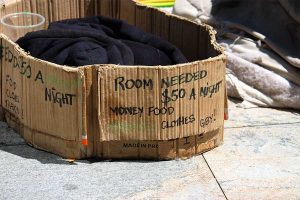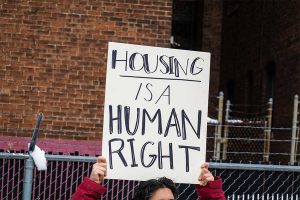Australians have always loved talking about housing; from how much our house is worth to renovations and even investment properties. But the housing conversation has changed recently.
Housing is now often spoken about through the prism of crisis. Conversations centre on how unaffordable housing is, for both buyers and renters. Even the lucky ones who own their homes are worried about how their children or loved ones will ever afford to enter the market.
Once, when people could not afford housing, we often (even if implicitly) thought about them as poor or disadvantaged. But now we are confronted with the alarming reality that housing is far too unaffordable for far too many people – even those we refer to as essential workers.
Housing unaffordability is no longer an individual problem for the poor or disadvantaged. We now have a housing problem.

We all need housing
Like food and energy, which have also become increasingly expensive in recent years, people cannot simply opt out of housing. It is not an exaggeration to say housing is a precondition to live well.
Housing is the foundation for family wellbeing, relationships and good health. Without access to safe, secure and affordable housing, we can’t fully participate in education, employment or our local communities.
Housing is essential and, tragically, can be a matter of life or death. When housing is unaffordable, people end up homeless or go without food for themselves or their families. In what can only be characterised as a profound injustice, for many women and children, the inability to afford housing means staying in – or returning to – violent relationships.
How did we get here?
On one hand, we have disinvested in social housing and other forms of housing that are affordable. And on the other, there has been a lot done at the policy level to ensure housing is a commodity to be speculated. Not simply a means for people to live, housing is a vehicle through which to become wealthy. For the lucky ones, anyway.
Staggering property prices and rental growth means housing in Australia, and in Queensland, has never been more unaffordable.
At the same time, the ballooning waitlists for social housing shows there is insufficient supply to meet growing demand.
Social housing is less than 4% of the entire housing market in Queensland, and there has been a steady decline in the national social housing profile since the early 1990s, when it constituted just over 6%.
When the market is as unaffordable as it is now, there is scant social housing to fill the gap. The decreasing supply of social housing has been an underreported problem for many years and policy makers should have seen this current crisis coming and responded better well before now.
Where to now?
Escalating concerns about the housing crisis – that is no longer hidden but now right on our doorstep – can create the impression that this problem is far too big to do anything about.
We should, rightly, be angry that affordable housing is out of reach for far too many. But we should also be aware of what is working to address the problem, and what these lessons of good policy and practice mean for the society we want to live in.
Our researchers have been working in partnership with innovative Brisbane-based not-for-profit organisation, Micah Projects, and this work offers some answers, and optimism, for what we can do differently. Through a range of interventions, and in collaboration with the Queensland and Australian governments, Micah Projects has shown what it takes to get people immediately from rough sleeping into secure and affordable housing.
UQ research has found that there is an annual saving of about $13,000 for each person that is supported to move from chronic homelessness to secure housing.
Key findings of our evaluation of Micah Projects programs include more safety and stability for families as well as increased parental confidence and child school participation. Our research into supportive housing with family-centred support also shows it can be a direct means to keep children safe and end statutory child protection interventions.
At the broader level, we also have strong evidence about what actually works to improve housing affordability, and what we need to do more of, including potential silver linings that emerged during the COVID-19 pandemic.
Providing income support that is above the poverty line will enable many Australians to move out of housing stress.
This is not just speculation or wishful thinking. At the height of the COVID-19 pandemic in 2020 and 2021, the Australian Government adopted a range of measures that meant income support for Australia’s poorest citizens nearly doubled, so these people could afford housing, food, and day-to-day family essentials.
UQ research in 2020 and 2021 highlighted how the Queensland Government’s responses to the impact of COVID-19 on renters and people experiencing homelessness, in conjunction with Australian Government income support measures, made a real difference.
The combination of government intervention, regulation and funding, integrated and innovative service delivery, private-sector support and local community action was critical. For a short time, secure housing was not purely a market-driven product, but rather a human right.

Innovative place-based focus
There is an urgent need to invest in a range of strategies to get more affordable and social housing on the ground, and in the right places. The confronting reality is that the market will not provide sufficient supply of affordable and safe housing for all citizens, without a suite of legislative and financial policy mechanisms from government, at all three levels.
Increasing the supply of social housing is a good place to start. There can often be local opposition to new social housing development but addressing this means ensuring the tenants who are allocated housing are provided with the full supports they need.
It’s important to bring the whole community together as part of a broader place-based strategy to integrate the planning, design, financing, and delivery stages of social housing with other community needs.
A more place-based strategy can also address an often-forgotten part of an effective housing response – better integration of the land-use planning system with housing planning and delivery to align local community needs, services and infrastructure.
We need to understand that social housing is a resource for all Australians. It’s not something for the distant other, but vital to the fabric of an inclusive society.
Finally, many people want to help those struggling with affordable housing, but there are currently very few means to provide people with the help to access the affordable housing they require.
Innovative finance and development models are needed to empower communities to fulfil their desire to help by contributing to the development and delivery of new affordable housing stock.
We need the models and structures to help people, not through soothing the consequences of their housing stress, but by providing them with what they need most – affordable housing.
